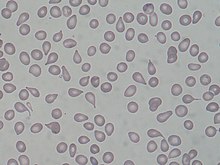Dacrocyte
Appearance

A dacrocyte (or dacryocyte) is a type of poikilocyte that is shaped like a teardrop (a "teardrop cell"). A marked increase of dacrocytes is known as "dacrocytosis". These tear drop cells are found primarily in diseases with bone marrow fibrosis, such as: primary myelofibrosis, myelodysplastic syndromes during the late course of the disease, rare form of acute leukemias and myelophtisis caused by metastatic cancers. Rare causes are myelofibrosis associated with post-irradiation, toxins, autoimmune diseases, metabolic conditions, inborn hemolytic anemias, iron-deficiency anemia or β-thalassemia.[1]
Etymology
From Ancient Greek, δάκρυον: a teardrop
References
- ^ Gütgemann, Ines; Heimpel, Hermann; Nebe, Carl Thomas (15 January 2014). "Significance of teardrop cells in peripheral blood smears". LaboratoriumsMedizin. 37 (5). doi:10.1515/labmed-2014-0005.
